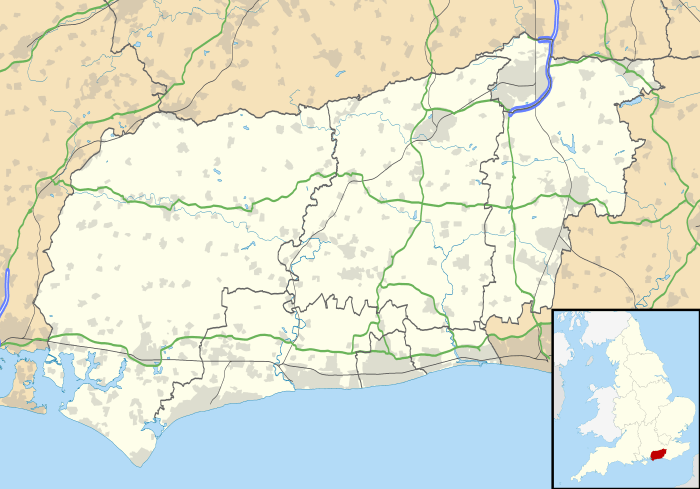Boxgrove
| Boxgrove | |
|---|---|
 Church of St. Mary & St. Blaise | |
 Boxgrove Boxgrove shown within West Sussex | |
| Area | 11.69 km2 (4.51 sq mi) [1] |
| Population | 957. 2011 Census[2] |
| • Density | 77/km2 (200/sq mi) |
| OS grid reference | SU907074 |
| • London | 51 miles (82 km) NNE |
| Civil parish |
|
| District | |
| Shire county | |
| Region | |
| Country | England |
| Sovereign state | United Kingdom |
| Post town | CHICHESTER |
| Postcode district | PO18 |
| Dialling code | 01243 |
| Police | Sussex |
| Fire | West Sussex |
| Ambulance | South East Coast |
| EU Parliament | South East England |
| UK Parliament | |
Boxgrove is a village and civil parish in the Chichester District of the English county of West Sussex, about five kilometres (3.5 miles) north east of the city of Chichester. The village is just south of the A285 road which follows the line of the Roman road Stane Street.
The parish has an area of 1,169 hectares (2,890 acres). According to the 2001 census it had a population of 901 people living in 423 households of whom 397 were economically active. The 2011 Census indicated at population of 957.[2] Included in the parish are the hamlets of Crockerhill , Strettington and Halnaker.
Governance
An electoral ward in the same name exists. This ward stretches northwest to West Dean with a total population taken at the 2011 census of 2,235. [3]
Archaeology
Boxgrove is best known for the Lower Palaeolithic archaeological site discovered in a gravel quarry known as Amey's Eartham Pit located near the village but in Eartham Parish. Parts of the site complex were excavated between 1983 and 1996 by a team led by Mark Roberts of University College London. Numerous Acheulean flint tools and remains of animals (some butchered) dating to around 500,000 years ago were found at the site. The area was therefore used by some of the earliest occupants of the British Isles. Remains of Homo heidelbergensis were found on the site in 1994, the only postcranial hominid bone to have been found in Northern Europe. Teeth from another individual were found two years later.
Boxgrove Priory
A Benedictine monastery was founded at Boxgrove by Robert de Haia (or de la Haye) early in the 12th century. The priory church remains as the Church of England parish church of St. Mary and St. Blaise, minus the original nave, and mostly dates from the 13th century.
Early cricket
Several parishioners of Boxgrove were prosecuted for playing cricket in the churchyard on Sunday, 5 May 1622. There were three reasons for the prosecution: one was that it contravened a local bye-law; another reflected concern about church windows which may or may not have been broken; the third was the now legendary charge that "a little childe had like to have her braines beaten out with a cricket batt"! The latter situation was because the rules at the time allowed the batsman to hit the ball twice and so fielding near the batsman was very hazardous, as two later incidents resulting in fatalities drastically confirmed. This is the earliest known reference to the cricket bat.[4][5]
References
- ↑ "2001 Census: West Sussex – Population by Parish" (PDF). West Sussex County Council. Archived from the original (PDF) on 8 June 2011. Retrieved 12 April 2009.
- 1 2 "Civil parish population 2011". Neighbourhood Statistics. Office for National Statistics. Retrieved 14 October 2015.
- ↑ "Ward population 2011". Retrieved 14 October 2015.
- ↑ McCann, p. xxxi.
- ↑ Leach, John (2007). "From Lads to Lord's; The History of Cricket: 1300 – 1787". Stumpsite. Archived from the original on 29 June 2011.
Bibliography
- McCann, Tim (2004). Sussex Cricket in the Eighteenth Century. Sussex Record Society.
External links
![]()